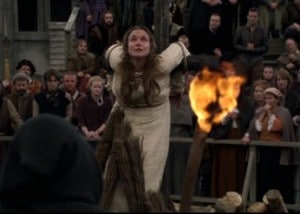
On this day in 1546 the Protestant martyrs Anne Askew, John Lascelles, John Adams and Nicholas Belenian were burned at the stake at Smithfield in London for heresy.
Anne had to be carried to the stake in a chair and “was tied by the middle with a chain, that held up her body” because hse had been racked “till her bones and joints were almost plucked asunder”.
The famous martyrologist, John Foxe, recorded the burning of Anne Askew and the men in his book Actes and Monuments, also known as Foxe’s Book of Martyrs. Here is what he says of Anne’s death:
“Wherefore the day of her execution was appointed, and she brought into Smithfield in a chair, because she could not go on her feet, by means of her great torments. When she was brought unto the stake she was tied by the middle with a chain that held up her body. When all things were thus prepared to the fire, Dr Shaxton, who was then appointed to preach, began his sermon. Anne Askew, hearing and answering again unto him, where he said well, confirmed the same; where he said amiss, “There,” said she, “he misseth, and speaketh without the book.”
The sermon being finished, the martyrs standing there tied at three several stakes ready to their martyrdom, began their prayers. The multitude and concourse of people was exceeding; the place where they stood being railed about to keep out the press. Upon the bench under St Bartholomew’s Church sat Wriothesley, chancellor of England; the old Duke of Norfolk, the old earl of Bedford, the lord mayor, with divers others. Before the fire should be set unto them, one of the bench, hearing that they had gunpowder about them, and being alarmed lest the fa*gots, by strength of the gunpowder, would come flying about their ears, began to be afraid: but the earl of Bedford, declaring unto him how the gunpowder was not laid under the fa*gots, but only about their bodies, to rid them out of their pain; which having vent, there was no danger to them of the fa*gots, so diminished that fear.
Then Wriothesley, lord chancellor, sent to Anne Askew letters offering to her the King’s pardon if she would recant; who. refusing once to look upon them, made this answer again, that she came not thither to deny her Lord and Master. Then were the letters like-wise offered unto the others, who, in like manner, following the constancy of the woman, denied not only to receive them, but also to look upon them. Whereupon the lord mayor, commanding fire to be put unto them, cried with a loud voice, “Fiat justicia.”
And thus the good Anne Askew, with these blessed martyrs being troubled so many manner of ways, and having passed through so many torments, having now ended the long course of her agonies, being compassed in with flames of fire, as a blessed sacrifice unto God, she slept in the Lord A.D. 1546, leaving behind her a singular example of christian constancy for all men to follow.”
You can read more about why Anne was executed in my article Anne Askew Sentenced to Death.
Trivia: John Lascelles was the man who told Archbishop Cranmer of Catherine Howard’s colourful past in autumn 1541. His sister Mary had been brought up with Catherine in the Dowager Duchess of Norfolk’s household and knew about Catherine’s relationships with Henry Manox and Francis Dereham.
John Foxe’s Actes and Monuments includes Anne Askew’s full story, including the examinations of her in 1545 and 1546, her confession of faith, her condemnation, her letter to Wriothesley, an account of her torture and her death. The book can be read online for free at the Google ebookstore – see http://books.google.com/ebooks?id=axUXAAAAIAAJ and read pages 537-551.
Anne Askew, John Lascelles, John Adams and Nicholas Belenian were not the only people to be burned for heresy on this day in history. On 16th July 1556, Julins Palmer, John Gwyn, and Thomas Robyns (some sources say Askew or Askin) were burned in the old sandpits in Enborne Road, Newbury, after they were found guilty of sedition and heresy. They are known as the Newbury Martyrs.